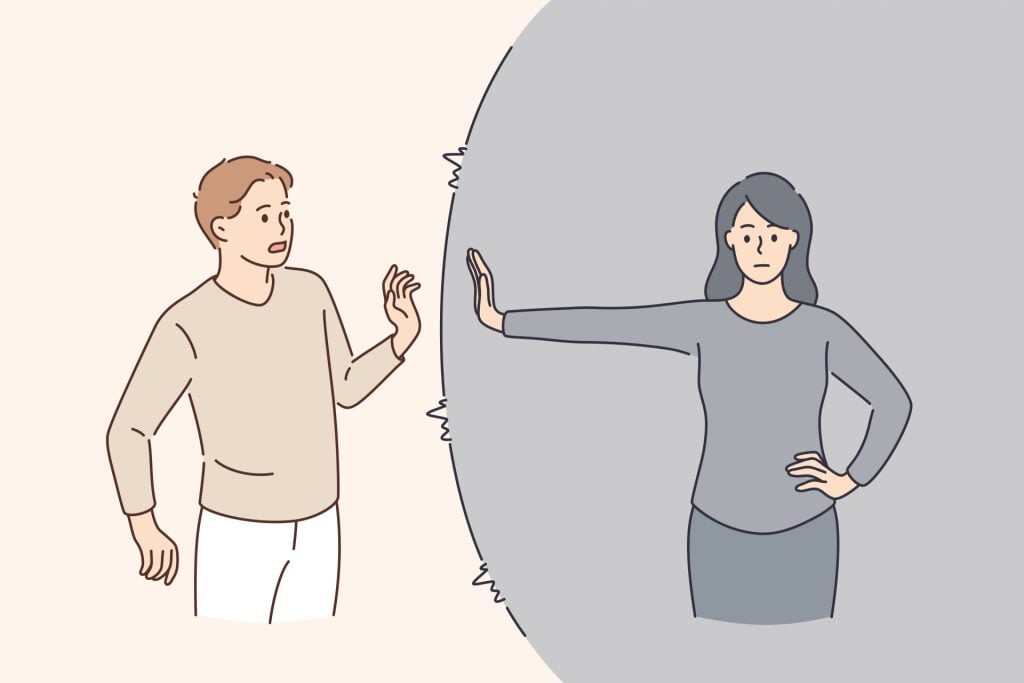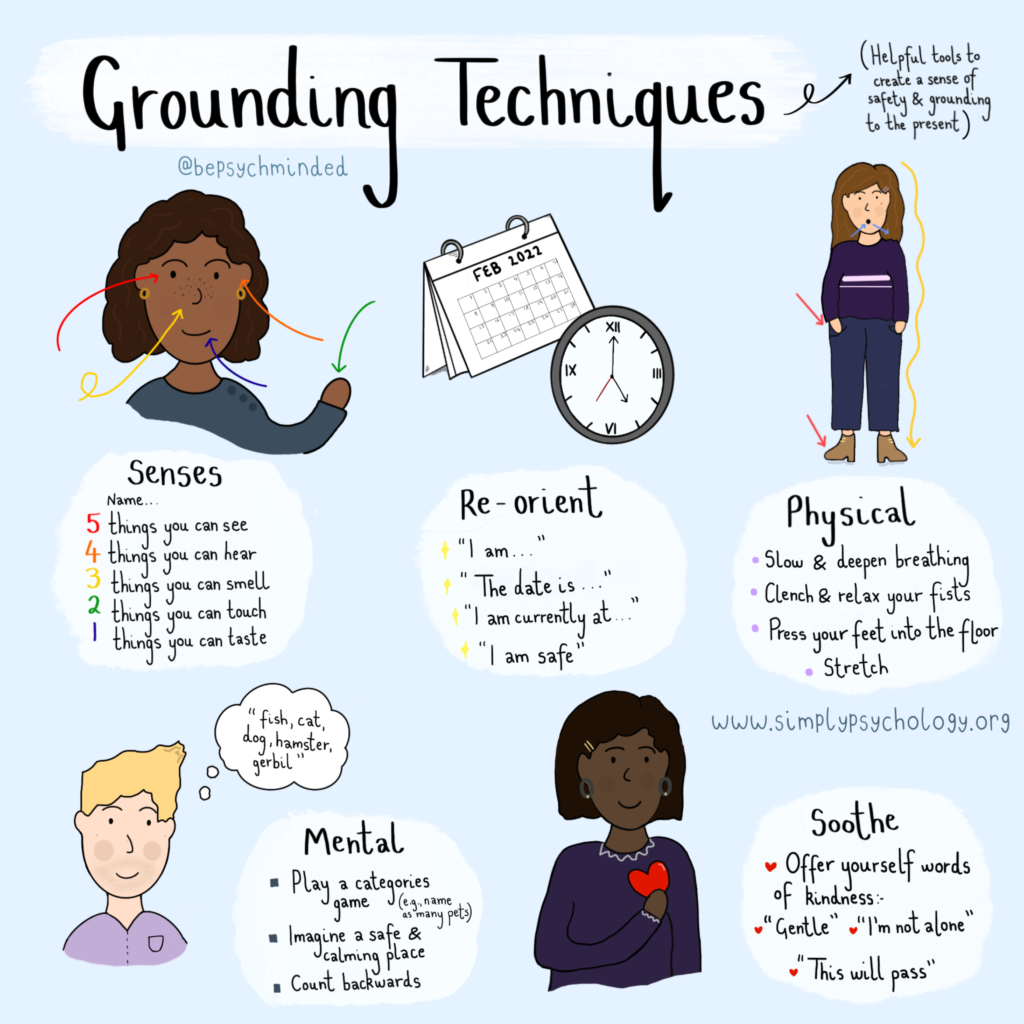On This Page:
Avoidant attachment style refers to a psychological and emotional pattern characterized by an individual’s tendency to avoid emotional closeness and dismiss the importance of intimate relationships, often as a self-protective measure.
Avoidant individuals tend to have a negative view of others and a mostly positive view of themselves. They believe other people are untrustworthy and dishonest, whereas they themselves are confident and capable and do not need the support of anyone else.

Individuals with an avoidant attachment style often have difficulty forming and maintaining deep emotional connections with others. They may feel uncomfortable with intimacy, fear dependence on others, and have a strong desire for independence and self-reliance.
This attachment style usually develops as a result of emotional rejection and neglect from primary caregivers in early childhood.
For these individuals, avoidance and withdraw becomes their strategy to protect themselves from experiencing more pain and abandonment.
How Avoidant Attachment Develops
To maximize their chances of survival, infants are born with an innate attachment drive. When they are frightened or distressed, their attachment system is activated, which leads to proximity-seeking behaviors towards caregivers (e.g., crying, clinging). Once they have achieved proximity and safety, their attachment system is deactivated.
Thus, the primary caregiver’s responsiveness and availability during infancy and early childhood play a crucial role in shaping a child’s attachment style.
Children who experience stable, safe, and sensitive caregiving tend to develop a secure attachment style – they expect to be safe and protected and can confidently explore the world.
Children whose caregivers did not respond sensitively and responsively to their needs and signs of distress often develop an insecure attachment style.
If the child’s bids for closeness, comfort, and safety were rejected and their emotional expression was punished or shamed, they may develop an avoidant attachment style.
Children with avoidant attachment may have experienced a lack of emotional or physical responsiveness from their caregivers. When they sought comfort or connection, their needs may have been consistently dismissed or ignored, leading them to believe that reaching out for closeness is futile or even met with rejection.
This leads a child to learn that it is best to suppress or minimize their needs and emotions to avoid disappointment or rejection.
These children tend to develop a highly independent personality, learning to rely on themselves for emotional support and soothing. They tend to become self-reliant and develop a strong desire for autonomy.
It’s important to note that attachment styles are not solely determined by early childhood experiences. Genetics, innate personality traits, and life experiences can also interact with the caregiving environment to create an attachment style.
Furthermore, attachment styles are not necessarily stable over time, and relationships later in life can also significantly impact shaping attachment styles.
For example, individuals who have healthy and high-quality friendships during their teenage years are more likely to be securely attached in adulthood.
Signs of Avoidant Attachment in Children
There are several common characteristics of children with an avoidant attachment style. These characteristics include: avoidance of physical closeness, independence and self-reliance, minimal seeking of comfort, emotional suppression, limited eye-contact, and difficulty with trust. Children with this attachment style are also highly sensitive
According to psychiatrist Dan Siegel, “[children] intuitively pick up the feeling that their parents have no intention of getting to know them, which leaves them with a deep sense of emptiness.”
They resist and avoid close contact with their caregivers to please them and prevent further rejection. This behavior and the sense of emptiness can make them seem aloof, unemotional, and precociously autonomous.
Here are some signs in more detail:
- “Down-regulating” their need for proximity and safety (i.e., they appear to manage their distress independently and do not seek comfort from caregivers)
- After a separation from the caregiver, the child acts distant and tends to avoid contact with the caregiver.
- “Pseudo-independence” (e.g., playing alone rather than with caregivers)
- Unemotional (e.g., when saying goodbye)
- Suppressing the need to cry
- Rejecting physical contact consistently
While these signs indicate that a child leans more towards an avoidant attachment style, they are not enough to classify a child as avoidant.
These signs have to be viewed in context. For example, if they see their best friend and are not sad to say goodbye, that does not necessarily mean they are avoidant; they may just be distracted.
Avoidant Attachment Signs in Adults
There are several common characteristics of adults with an avoidant attachment style. These characteristics include: valuing independence over emotional closeness, suppressing or downplaying emotions, distrusting others, relying on themself for emotional support, and struggling to share their thoughts and feelings with others.
While outwardly these individuals often come across as confident, fun-loving, social, and easy-going, they tend to have acquaintances and sexual partners rather than close friendships and committed relationships.
Here are some signs in more detail:
- “I am comfortable without close emotional relationships.”
- “It is very important to me to feel independent and self-sufficient.”
- “I prefer not to depend on others or have others depend on me.”
People with this attachment style may not openly or consciously experience distress or the need for comfort, but their attachment insecurity is a sign of low self-worth. These individuals often display symptoms of poor mental health, such as depression and anxiety.
Personal Account
Here is a personal account of someone with an avoidant attachment style:
“I have known I’m a dismissive avoidant for some time now and the main thing I really want to stress is that this avoidance is almost entirely subconscious on our part unless someone brings our attention to it.
I had no idea I was doing this for years and years and the result was that I truly hurt a lot of people. In college, I started having unexplained physical symptoms (stomach ache, vision changes, heart palpitations, chest pain) which were later determined to be anxiety and depression after the doctors ruled literally everything else out […]
I would be dating a guy who I initially really liked, but as the relationship wore on I would decide they were not good enough due to some fatal flaw and they couldn’t possibly be “the one.” This decision always happens to coincide with these men wanting more commitment.
I loved casually dating, but the second someone wanted to make things official or get emotionally closer, I would suddenly end it, much to their surprise […]
Interestingly, I would become deeply lonely and sad during single periods but would continue the same process or pull away as soon as I started to get close to someone.
Following that I’d become lonely and sad again. I thought my problem was that “the one” was not out there […]”
Triggers of Avoidant Attachment
Avoidant individuals tend to feel overwhelmed and uncomfortable when another person wants to be emotionally vulnerable and physically intimate.
This is because they have learned that depending on others, wanting to be close, and looking for support will be met with rejection. For them, it is easier to suppress these needs altogether and avoid deep emotions and intimacy.
Certain relational scenarios trigger an avoidant individual’s maladaptive beliefs and behaviors.
Some examples include:
- Another person wants them to open up more
- Someone texts or calls them often
- It feels like someone is demanding their attention
- Their partner makes plans for future commitments (e.g., marriage, children, or a summer vacation)
- Romantic gestures
- They feel criticized
- A friend or partner is emotional and wants comfort
- Physical contact and intimacy when they are not in the mood
Deactivating Strategies
Avoidantly attached individuals deal with these situations by pulling away, breaking up with their partner, or physically and emotionally distancing themselves from friends and family.
These are called “deactivating strategies” and serve the function of sustaining a comfortable space between themselves and other people.
In essence, they are strategies for protecting themselves from re-experiencing the pain and disappointment they experienced early in life.
However, these behaviors are damaging to the health and stability of relationships and can confuse and upset their loved ones. They also prevent avoidant individuals from experiencing the benefits of intimacy and the joys of sharing deep bonds with other people.
That is why healing an avoidant attachment style is worthwhile and rewarding.
Healing Avoidant Attachment Style
Healing an avoidant attachment style involves self-reflection, self-awareness, and actively working on developing healthier patterns of relating to others. This may demand time, effort, and help, but change is possible.
First, you must educate yourself about attachment theory and gain a deeper understanding of avoidant attachment. Understanding your attachment style and addressing your avoidant tendencies can help you towards a more satisfying, interconnected, and well-deserved life.
You must also explore any early childhood experiences or significant relationships that may have contributed to the development of your avoidant attachment style.
It is also important to learn to identify and express your emotions. Healing is not merely about changing behavior, as this often triggers compensatory behavior.
Rather, healing lies in transforming your unconscious beliefs and assumptions underpinning your avoidant attachment behavior. Examine and challenge any negative beliefs or expectations you hold about relationships, intimacy, and vulnerability and replace them with more realistic and positive beliefs that promote healthy connections.
Avoidantly attached individuals unconsciously fear that their emotional needs will lead to rejection. To heal, these expectations must be contested through new experiences that correct past childhood experiences. This may involve sharing your fears, desires, and insecurities with trusted individuals. Practice being present and open to emotional intimacy.
These experiences can gradually shape a new internal model of relationships. There are various methods to facilitate this belief alteration.
Benefits of Healing an Avoidant Attachment
- Enhanced Relationships: Cultivating a secure attachment style enhances emotional expression and strengthens bonds, leading to deeper, more meaningful connections.
- Boosted Emotional Well-being: This transition can reduce feelings of isolation and increase fulfillment and connectivity.
- Increased Self-awareness: Understanding personal emotions, needs, and tendencies allows for more intentional relationship choices.
- Improved Parenting: As a less avoidant parents, you can forge closer connections with your children, fostering their emotional regulation and secure attachment.
- Better Emotional Regulation: Healing enables individuals to handle emotional challenges without harming relationships.
- Strengthened Self-worth: Recognizing and valuing personal emotions and needs increases self-respect and self-love and reduces shame and self-doubt.
- Improved Communication Skills: Healing bolsters the ability to express emotions and needs effectively, listen actively, and respond healthily to others’ emotions, enhancing emotional intelligence and averting relationship issues.
Self-Regulation Strategies for Avoidant Attachment Triggers
Although they may not be aware of it, avoidantly attached people often suffer from low self-esteem and mental health challenges. This is likely because they suppress their feelings and emotions rather than allowing others to provide emotional support.
It is important to learn how to become more comfortable with asking for support and fostering relationships where you feel safe and valued.
Self-regulation strategies are good ways to manage difficult emotions, such as the overwhelming urge to run away when others want to get close.
These strategies are about learning to sit with your emotions by becoming conscious of their existence, observing them, and then challenging them with compassion.
Learning to manage attachment insecurities is a process that takes time and patience, but the end result is worthwhile.
Here is some advice to get you started:
Healthly Communication
Healthy communication is fundamental to overcoming avoidant attachment. By creating a channel for yourself and others to effectively convey emotions and needs, you will foster profound, meaningful connections.
The development of active listening skills and assertiveness plays an integral part in this process. Active listening involves engaging in conversations and accurately interpreting the speaker’s sentiments, establishing trust and emotional connection.
Assertiveness, on the other hand, pertains to the direct and clear articulation of emotions and needs while respecting others’ feelings and boundaries. This is a delicate balancing act that prevents avoidance of difficult discussions and promotes emotional intimacy and respect.
Empathic communication and boundary-setting form the second pillar of healthy communication. Empathy requires understanding and validating others’ emotions while comfortably expressing your own, thus creating a nurturing environment for emotional intimacy.
Setting boundaries, while complex when the limits aren’t clearly defined, involves establishing what one is willing to accept in a relationship and respecting others’ boundaries. This ensures emotional safety and trust in the relationship.
Lastly, the practice of conflict resolution is crucial. It involves handling disagreements respectfully and effectively, validating each other’s emotions and needs, and collaboratively problem-solving.
Although open communication can be challenging due to the need for emotional control and teamwork, it will help prevent emotional disconnection and promote intimacy and connection.
Expressing your needs and desires to your loved ones
At the heart of it, individuals with avoidant attachment tend to fear revealing intense emotions or appearing in disarray. Hence, having open, transparent conversations in a relationship is the cornerstone of effective emotion regulation.
Both parties should strive for lucid communication to voice concerns without fear of judgment. Gradually, adults with an avoidant attachment will come to understand that discussing their emotions is healthier than suppressing them.
Be specific and clear: Make your needs and desires known clearly and in detail to prevent misunderstandings. Utilize specific wording and steer clear of vague or unclear statements.
This will aid your loved ones in fully comprehending what you are asking for.
Employ “I” statements: When expressing your needs and wishes, use “I” statements as they help to evade an accusatory or confrontational tone.
Instead of saying, “You never assist with the housework,” you could say, “I feel overwhelmed when I’m left to do all the housework, and I would appreciate some assistance.”
Welcome feedback: While articulating your needs and wishes, be receptive to feedback and be ready to participate in constructive discussions.
This encourages you and your loved ones to discover solutions that are satisfactory to all parties involved.
Allowing yourself to trust others
Embrace openness and vulnerability: Start gently letting your guard down and becoming more open and vulnerable with others by disclosing your thoughts, emotions, and experiences.
This will aid in forging trust, emotional bonding, and a secure environment for emotional expression. Focus on cultivating trust with your loved ones by demonstrating honesty, transparency, and dependability.
Establishing trust will generate a comfortable environment for you and your loved ones to articulate your needs and wants without hesitation.
Cultivating trust and vulnerability can be transformative. It is best to practice this with a securely attached partner in an environment that allows for safe vulnerability. Despite initial discomfort, repeated positive responses will lessen unease.
Therapy can be a valuable alternative. Specifically, a therapist trained in emotion-focused therapy can assist in expressing emotions effectively.
Identifying and Expressing Emotions
Because of your expectations of other people and relationships formed in your younger years, your patterns of thought, feeling, and behavior are mostly automatic and subconscious.
That means you may not be aware of why you think, feel, and behave the way you do. In order to create change, you must first become aware of what is happening within you when it comes to relationships.
If you have established that you have an avoidant attachment style, pay close attention to situations that make you feel uncomfortable and provoke a need to shut down or run away.
What thoughts go through your mind? How does your body feel? What is your mind telling you to do?
When you are mindful of these situations and how you are feeling, it’s much easier to intervene. Ask yourself: Am I pushing someone away because I’m scared of getting close? Am I not asking for support because I fear they will reject me?
Take time and observe what is happening in your mind and body before reacting automatically. It can be helpful to write these thoughts down in a journal to process your emotions, set goals, and track your progress.
Regulating Your Nervous System
When your need to avoid is triggered, it means your nervous system and the fight/flight/freeze response has been activated. When this happens, you go into a trance state where your reactions become subconscious.
Practicing mindfulness and becoming conscious of what’s happening within us is easier when you learn how to regulate your nervous system and automatic reactions.
You can do this by practicing grounding techniques, such as breathing exercises, progressive muscle relaxation, and mindfully connecting with nature.

The more you practice these, the more control you will gain over your mind and body. That means, you should practice grounding regularly, both when you are and when you are not experiencing the need to avoid.
Understand The Origin Of Your Attachment Style
Your attachment style stems from early childhood experiences, which may account for their unconscious nature.
Delving into these memories can help you pinpoint the origin of your unconscious thoughts. Gaining awareness and articulation of these beliefs enables their transformation.
Therapy can be instrumental here. A competent therapist can unearth and process the foundation of your attachment style, assisting you in fostering a secure and fulfilling relational pattern.
Comfort Your Inner Child
A technique that helps to heal the wounds of the past is to mentally revisit your childhood and engage with your child-self with understanding and kindness.
For whatever reason, your caregivers, friends, and/ or partners were unable to meet your needs adequately and may have behaved in damaging ways toward you.
Tell your child-self that it was not their fault; they did whatever they could to survive and what they experienced was painful and undeserved.
Have compassion for yourself and acknowledge that it’s okay to feel sad or angry about the way you may have been treated.
Once you have acknowledged this, it’s easier to let go of the fear of rejection, learn how to be intimate, and ask for help. The past does not have to control the present and future.
Therapy
Although you can do a lot of this work on your own, it is often helpful to have a therapist who can help you through this process. It’s also an opportunity to practice asking someone for help.
A therapist can discuss attachment theory with you and help you to identify and challenge your avoidant beliefs and behaviors.
They can also be a (temporary) secure attachment figure for you and demonstrate what a trusting and reliable relationship looks and feels like.
Behavioral Experiments
Once you have established a practice of self-regulation strategies, you can do some behavioral experiments in the form of practicing secure behaviors.
The best way to change beliefs and thought patterns is to have evidence for your ability to behave and feel more secure.
Examples of behavioral experiments include:
- Allowing yourself to receive emotional support from someone
- Asking for help when you are feeling low or stressed (e.g., telling someone what you are feeling and ask them for advice)
- Talking to someone about difficult experiences you have had
- Listening to the concerns of someone else without withdrawing or changing topics
- Making a list of things you like about another person
- Keeping a gratitude diary in which you focus on the positives of the day, making a list of your strengths, and writing down when other people have been kind and supportive
Sources
Fraley, R.C., Roisman, G.I., Booth-LaForce, C., Owen, M.T. & Holland, A.S. (2013). Interpersonal and genetic origins of adult attachment styles: a longitudinal study from infancy to early adulthood. Journal of Personality and Social Psychology, 104 (5), 817-38.
Nickerson A, Nagle RJ. Parent and peer relations in middle childhood and early adolescence. Journal of Early Adolescence. 2005; 25:223–249.
Sheinbaum, T., Kwapil, T.R., Ballespí, S., Mitjavila, M., Chun, C.A., Silvia, P.J. & Barrantes-Vidal N. (2015). Attachment style predicts affect, cognitive appraisals, and social functioning in daily life. Frontiers in Psychology, 18 (6), 296.
Simpson, J.A. & Rholes, W.S. (2017). Adult Attachment, Stress, and Romantic Relationships. Current Opinions in Psychology, 13, 19-24.


